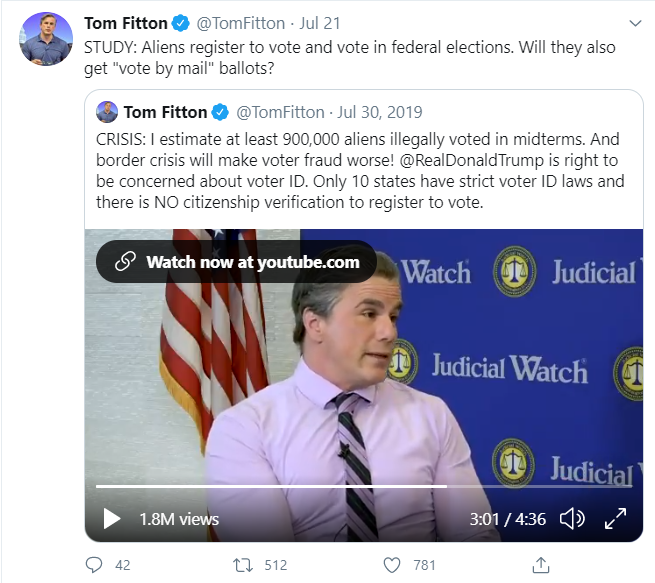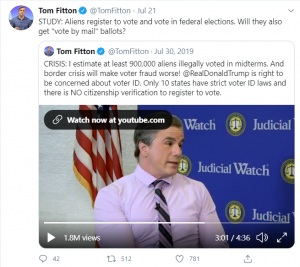Last week I went down the rabbit hole of looking up the study by Jesse Richman and colleagues purporting to quantify the extent of voting among non-citizens in the United States in the 2008 and 2010 elections. I and other people have very serious concerns about their analyses. But setting that aside I was very curious about the “estimate” that Tom Fitton gave in this Judicial Watch video about the number of non-citizens voting in the 2016 and 2018 elections:
I’ve calculated, because there’s this study, I don’t know if you’ve seen it, Bruce, out of Old Dominion University, we’ve talked about it extensively here at Judicial Watch. And it’s a numbers game. You’ve got XX million numbers of illegal aliens and just aliens who are here lawfully, they have green cards, and a percentage of them are going to register to vote, both in a knowingly criminal way, and accidentally. And of those, a percentage are going to vote. And they vote in large enough numbers to influence elections. It makes sense. And when you look at the numbers from the study you extrapolate them for instance to 2016, I’d estimate about 1.2 million aliens voted in the presidential election…you look at them in 2018, those numbers, given the turnout, I’d estimate you had 900,000 aliens unlawfully vote in the mid-term elections.
Now, I want to be very clear here, extrapolation is very fraught, and especially so in this context. I have expressed my deep skepticism that the number of non-citizen voters is above “negligible” on the grounds that voting is irrational for citizens in a pure cost-benefit analysis (because your one vote very unlikely to to sway an election), and it is especially irrational for non-citizens, who face even more costs in terms of being caught voting illegally. Even if we give credence to Richman et al.’s estimates of the prevalence of non-citizen voting (and I don’t), we have good reason to believe that, given the vigorous anti-immigration policies pursued by the Trump administration, non-citizen propensity to vote went down for the 2018 midterm out of fear of being caught.
But again, let’s just set these serious reservations aside and see how the calculations turn out.
Richman et al.’s “best estimate” for the percentage of non-citizens voting in the 2008 and 2010 elections are 6.4 and 2.2, respectively. We could assume that 6.4 percent of non-citizens vote in presidential elections and that 2.2 percent of non-citizens vote in mid-term elections and these turnout rates are constant. We could apply those percentages to the number of adult non-citizens living in the United States in the late 2010s (20,431,595) to estimate the counts of non-citizens voting in 2016 and 2018 and we would get 1.31 million votes in 2016 and 450,000 votes in 2018. So Fitten is in the ballpark for 2016 but pretty far off for 2018.
Now, as Fitton said, turnout differs from year to year. So instead of assuming that non-citizen voting turnout is fixed in presidential and mid-term elections, we could instead assume that the share of votes from non-citizens is fixed. For presidential elections, that would be 1% of votes (based on the 2008 numbers; 1,260,606/131,313,820) and for midterm elections that would be 1.5% of votes (based on the 2010 numbers; 440,315/87,134,148). In 2016, that 1% would translate into 1.37 million votes (136,669,276*.01) and in 2018 that 1.5% would translate into 580,000 votes.
I don’t really know what Fitten did to get his extrapolations. This is definitely a case of “garbage in, garbage out”, but to the extent you want the second-best handling of the garbage (the first being to ditch it altogether), I think my extrapolations do the job, and by this reckoning, Fitton is underestimating the turnout in 2016 by .17 million (or 12%) and over-estimating the turnout in 2018 by around .32 million (or 36%). I put in a query to Judicial Watch and we’ll see if they answer (I kind of doubt it).

